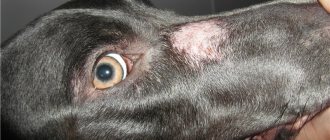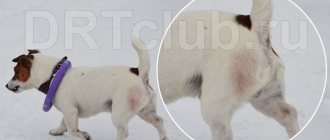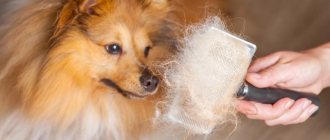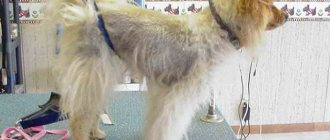Unlike colored hair containing melanin, white porous hair gets dirty faster. Therefore, white wool requires more careful care. Lack of proper care for the white coat of dogs very quickly leads to the fact that the snow-white coat becomes yellow.
Even regular removal of dirt will not get rid of yellowness and tarnishing. There are many reasons why white fur turns yellow or red. The most common of them are low-quality food, proteins contained in saliva, tears and urine, and cosmetics.
White dogs get dirty faster
No and no again! The coat of healthy white dogs is protected by the same mechanisms as the coat of dogs of other colors. The dirt dries and simply falls off, leaving no trace of contamination. If the dog constantly gets dirty, most likely it is unhealthy or infected with parasites.
If the dog has not been bathed for a long time, its fur becomes greasy. In this case, you need to use a special shampoo for white wool. The fact is that regular shampoos can lead to loss of shine and the appearance of a gray or yellow tint.
How to bleach dog fur at home
You can preserve the coat of a white dog using home remedies, but the results do not last long compared to commercial products.
If it is not possible to regularly bathe a white dog, then you can keep the coat clean by dry brushing. To do this, use corn starch and baby powder. It is better to clean it outside or cover the floor surface with newspapers. Then starch (powder) is generously applied to the wool and the product is distributed using massaging movements of the hands. After this, carefully remove the starch with a brush.
If the fur has acquired a gray or reddish tint, baking soda, which is mixed with a small amount of water to a paste consistency, gives a good result. The paste is applied to the yellowed area, left to absorb for a few seconds and washed off with water.
You can bleach your dog's fur at home using a bleaching paste you prepare yourself. To do this, mix 3% hydrogen peroxide and milk of magnesia (magnesium hydroxide, laxative), 1 tsp, in equal quantities. corn starch. Mix all components to a homogeneous paste. The paste is applied to the stains and allowed to dry for several hours. The paste is then removed by thoroughly combing the coat using conditioner. It is important to prevent the dog from licking the paste, therefore, if the dog is able to reach the treated area with his tongue, a protective collar should be used.
Tear tracks in white dogs are a common problem and can be painful. Therefore, first of all, you should visit a veterinarian to rule out all possible causes that require treatment. Red or brown tear tracks can be infectious. Therefore, in some cases, antibiotics may be prescribed, after treatment with which the natural color is restored. To remove tear tracks that are not caused by illness, dog owners find apple cider vinegar effective, 1 tsp daily. added to dogs' drinking water.
Tear tracks can be removed at home in another way. To do this, equal amounts of water and 3% hydrogen peroxide are mixed. The resulting solution is used to remove tear tracks using a cotton swab. It is important to be careful and avoid getting the solution in the dog’s eyes. Then the treated area is cleaned with plain water, removing any remaining dirt and solution.
Or maybe wash it with your own shampoo?
Before discussing whitening shampoo, let's look at the importance of dog shampoo in general.
It should be clarified that frequent use of human shampoo to wash a dog has a negative impact on the health of the coat and skin. In addition to causing skin problems, human shampoo can have a very negative impact on your dog's coat. Hair loss after bathing is a common consequence of using the wrong shampoo. The reason is that dogs have a much higher skin pH level, making it much more sensitive to the acidic environment of human shampoo.
Read also
Epithelium of the skin and intestines
1. Epithelium of the skin and intestines The epithelium of the skin is multilayered, and its stem cells are located in the lower (basal) layer, lying on the membrane separating the epithelium from the connective tissue. Cell divisions occur in the basal layer, and some cells are displaced into
ELECTRICAL ACTIVITY OF THE SKIN
7. ELECTRICAL ACTIVITY OF THE SKIN Electrical activity of the skin (ESA) is associated with the activity of sweating, but its physiological basis is not fully understood. From the central nervous system to the sweat glands influences come from the cerebral cortex and from the deep
Skin functions
Functions of the skin The skin primarily represents a kind of barrier that protects the internal environment of the body from external influences. It is the skin that determines the individuality and outline of the body of animals, being the border between the body and
Areas of skin irritation
Areas of skin irritation Areas of skin irritation occur in dogs (less often in cats) in the warm season, when symptoms of allergies to flea bites, pollen, etc. usually appear. The main symptom of the disease is severe itching, which causes dogs
6.3.1. Horny skin derivatives
6.3.1. Horny skin derivativesClaws are hard skin derivatives consisting of dead keratinized epithelial cells with a high keratin content. Dogs have open claws (non-retractable). Inside the keratin sheath in the claw there is living tissue, abundantly supplied
Diseases of the skin and subcutaneous loose tissue
Diseases of the skin and subcutaneous loose tissue Eczema. Eczema is a disease of the superficial layers of the skin, accompanied by polymorphism of rashes. Dogs are more susceptible to this disease than other animals. According to statistics, dogs that are sick
Skin diseases
Skin diseasesHair loss. Baldness. Alopetia Hair loss, in the absence of any skin diseases, is usually observed after serious illnesses, in the last period of pregnancy, after depleting bitches feeding puppies, gastric disorders and in too
Hyperemia. Redness of the skin. Erythema. Purpura cutaneum
Hyperemia. Redness of the skin. Erythema. Purpura cutaneumThe causes of skin hyperemia are very diverse, for example, skin irritation in short-cropped dogs, rubbing with a collar or harness in working dogs, irritation of the abdomen of urine (with catarrh of the bladder), acute bowel movements
Skin parasites
Skin parasites[Parasitic skin diseases can be of both plant and animal origin. Plant parasites include only a few mold fungi, while animal parasites that settle on the skin and in its skin include fleas, lice, lice,
Chapter 8. Skin parasites and some diseases they cause
Chapter 8. Skin parasites and some diseases they cause Ticks Ixodid, or pasture ticks. Temporary parasites of dogs. They are found in all parts of the world, but mainly in forest, forest-steppe and steppe zones. More than 60 species of ixodid ticks are known in the USSR. Many types
Why use whitening shampoo
Fur that has bunched up in clumps, lack of shine and a gray “patina” spoil the aesthetic appearance of the dog. In addition, wool in poor condition cannot protect the pet from wind and other natural phenomena.
Owners who care but don't know what to do make two common mistakes:
- They lighten the dog's fur using chemicals.
- They cut the dog's hair so that spots that have changed in the light are not visible.
Whitening shampoo is a healthy and safe alternative. The shampoo not only dyes the coat white, it restores and enhances the whiteness of the coat due to its effect on intercellular metabolism.
Diagnostics in a veterinary clinic
If there are changes in the dog's appearance, it should be taken to the veterinarian. Spots on the skin or changes in coat color indicate hidden pathologies occurring in the dog’s body.
The specialist, after conducting an examination, prescribes an examination with tests:
- blood tests - general and biochemical;
- urine analysis - general and electrolyte;
- skin scrapings for bacterial and fungal cultures;
- samples of fluid from the animal's joints to rule out lupus if the symptoms are typical for it;
- ultrasound examination of the thyroid gland, kidneys and adrenal glands;
- skin tests for allergic reactions.
Shampoo is different from shampoo
There are different types of whitening shampoos, each designed to achieve a specific effect:
- Shampoos with a blue effect. Blue shampoos give an optical enhancement of whiteness. Simply put, the coat appears whiter and brighter than it is. The blue color “clogs” the gray, while the wool itself does not turn blue.
- Clarifying shampoos. They add brightness and remove stains, but should be used with caution. Clarifying shampoos are effective; they perfectly remove even stubborn stains, including styling cosmetics (waxes, varnishes, mousses). However, they should not be used too often as they are harsh and may cause harm to the skin.
- Enzymatic shampoo. Dissolves particles of even the most stubborn dirt, making the product effective for removing urine, blood, tears and saliva stains.
- Whitening shampoos. A radical solution that must be handled with extreme care as it can remove color from pigmented coats and skin. If used frequently, the product can dry out the coat and “burn” the skin.
- Shampoos based on dyes. Finally, there are shampoos that, instead of removing them, cover up stains.
Main reasons
There are many reasons that cause changes in color, but the vast majority of them are not dangerous and are associated with natural causes and environmental effects on the fur. Therefore, when you notice yellowed hairs, you should not panic. But you shouldn’t let things take their course, otherwise the effect will intensify.
In addition to the fact that sometimes this symptom indicates infection with a fungus, the main problem becomes aesthetic. A snow-white dog with yellow tan spots or a white and gray husky with a reddish head and paws look ugly and not well-groomed.
Feed
A snow white puppy may turn yellow due to the wrong food. Dog food manufacturers add ingredients to enhance color saturation. Initially, they will make a red dog bright and even more beautiful, but white and gray will only spoil the fur coat, causing the hairs in it to turn brown.
When choosing dry food, pay attention to the presence of algae, carrots and beets in the composition. The percentage of their content should be low.
Because of food, the color of the fur changes completely from base to tip. After a few weeks of feeding, the color will return to normal, but the ends will still remain tinted.
In puppies, this symptom is also an indicator of problems with the digestive system. This problem especially often occurs in the Westie breed.
Allergy
Allergies to food, plants or any other drugs or substances surrounding the pet can also cause darkening of the hair, especially in the eye area.
Additional symptoms in this case are redness of the skin and an unpleasant sweetish odor. If you leave this problem without proper attention, do not take antihistamines, and do not identify and eliminate the allergen, then severe dermatitis will develop over time.
Sun and water
Very often, owners notice that after a trip to the dacha and active recreation there, their once white animal acquires yellow or even brown markings on its belly, chest, paws and tail.
In this case, natural factors such as the sun and water are to blame, which together provoke fading of the coat and a change in its color in light breeds to a darker one. This is a purely decorative effect, which special shampoos will help get rid of.
Fungus
Constantly getting the fur around the mouth and paw pads wet often leads to fungal infection.
Along with the change in color comes an unpleasant odor, which signals illness. In this case, before starting to restore the color, it is necessary to cure the root cause with the help of special ointments. And in the future, avoid constantly getting these areas wet. Dry your paws thoroughly after walks and your face after eating.
In addition to the above, frequent causes of problems are fluids secreted by the dog:
- Tears.
- Saliva.
In many breeds they contain special enzymes that can affect the pigmentation of hairs. If your dog is one of these, then stock up on a special shampoo to restore the white color. You will have to use it regularly throughout the animal’s life.
Many breeds that have snow-white coats or white patches of fur tend to turn yellow. If you are the owner of one of these dogs, then constantly pay attention to the condition of the hair and regularly carry out whitening treatments.











